Our company is involved in molecular assisted breeding since the late eighties. Marker technologies evolved from isozymes, RFLP, RAPD to nowadays SNPs and CNV markers. The use of marker information was primary dedicated to germplasm characterization for identification purposes and genetic diversity analyses. However, breeders rapidly understood the benefit of using marker information to get new insight into their germplasm. For example, in maize, to understand and maintain the heterotic pattern is of primary importance to increase hybrid vigor. Markers are useful in exploring and introducing new diversity alongside maintaining the heterotic structure for high yielding hybrids. In oil seed rape (OSR), hybrid varieties were developed recently with the advent of hybridization methods like the OGU system. OSR breeders used markers to explore their germplasm and create heterotic pools that will evolve separately to increase heterosis.
Another important application in breeding is the advance of markers linked to traits of interest. In sunflower for instance, numerous key agronomic traits are simply or relatively simply inherited but time and money consuming to be tracked with traditional breeding methods. Markers linked to disease resistance genes were among the first tackled and used in marker assisted breeding. Resistance genes where introduced into an already existing variety through repetitive backcrossing (the ‘conversion process’) or screening a segregating breeding population where only one parent is bearing the resistance allele. Rapidly, marker selection allows breeders to cumulate positive alleles at valuable genes in early phases of the inbred line creation process. Designing markers to track a simply inherited characteristic became a common activity for the molecular breeder. Methods were refined to find a marker or a subset of markers in complete linkage disequilibrium (LD) with the gene of interest in order to avoid any “mislabeling” of the target gene in the marker selection process. Determination of the allele specific polymorphism is the ultimate refinement in marker trait selection and lead to a single marker that is diagnostic of specific characteristic.
Finally, the major challenge in molecular breeding refers to the use of markers to improve quantitative, complexly inherited characteristics. Identification of Quantitative Trait Loci (QTL) involved in complex traits like earliness, height or yield was pioneered by Euralis since the early nineties. Methodologies to cumulate favorable alleles at many QTL throughout the selection process were developed and many projects were conducted in different crops. Nowadays, genotyping capacities sharply increased, allowing a whole genome scan of thousands of individuals. Genomic selection methodology originally developed in animal genetics is applied at different levels of the selection process in crops.






